Microsoft at MWC 2015: Lumia 640 and 640 XL Announced, 4K 120Hz Surface Hub Demoed
by Ian Cutress & Andrei Frumusanu on March 2, 2015 4:13 AM EST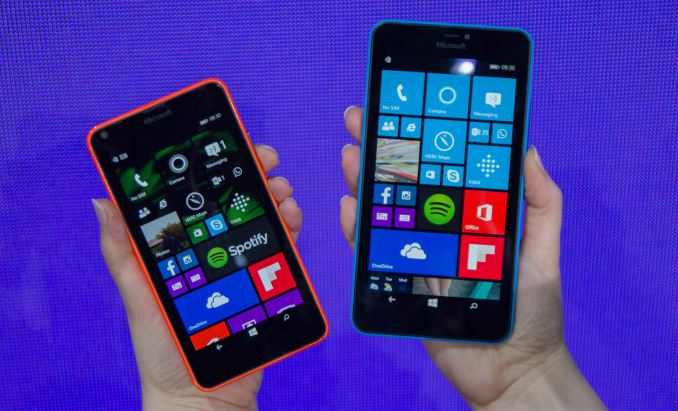
Mobile World Congress is in full swing today and Microsoft woke the press up early to discuss new features coming to their smartphone and tablet space. Top of the bill, presented by Stephen Elop, are the new Lumia 640 and Lumia 640XL devices. The regular 640, with it 5-inch HD display comes as the upgrade from the 630, whereas the 5.7-inch XL version sits as the move up from the large Lumia 1320.
Both devices will be available in 3G and LTE versions, with single and dual SIM in both of those depending on the market. The 640 uses a Snapdragon 400-series quad core processor at 1.2 GHz featuring Gorilla Glass 3, 1 GB of DRAM and 8 GB of storage. One might expect SD card support to come as standard, although a short hands on with the device failed to find one. The rear 8MP camera was described as a wide angle lens (although no numbers were given), with auto-HDR and dynamic LED flash. The battery weighs in at 2500 mAh also. Pricing for the 3G model starts at 139€ with the LTE version at 159€.
The 640 XL was described as ‘a slim 9mm’ with similar specifications to the smaller model but at 5.7 inches, namely a 1280x720 screen but the battery is pushed up to 3000 mAh. Internal specifications were not discussed, but the rear 13MP camera features Zeiss optics. Pricing starts at 189€ for the 3G model with LTE at 219€.
Both devices will ship with Windows 8.1 but will be upgraded to Windows 10, with Microsoft going all out to encourage Windows 10 across all of its future devices when available. The 640 and 640XL will also come with one year of Office 365, allowing installation on one PC and one other device as part of the deal. It also comes with 1TB of One Drive storage and 60 Skype World minutes.
An interesting element to the launch, especially with the ‘seemless feel’ push of Office across all different sizes of devices, was the Microsoft Universal Portable Keyboard. Barely bigger than a wallet, it is designed to fit into an office bag and be able to connect seamlessly via Bluetooth. No pricing or date was announced, but the focus was more on the office environment.
One demonstration that took me (Ian) by surprise was that of the Microsoft Surface Hub. This was an 84-inch display, normally the size used by large scale demonstrations, but this featured 4K resolution at 120 Hz as well as touch screen functionality. Naturally my thoughts drifted towards a TN type panel using MST, although taking the typical wide-angle test for TN panels was confusing as color consistency remained the same – it seems like they are using some kind of IPS display, which seems odd at 120 Hz.
The combination of 4K and 120 Hz and possibly IPS is mind boggling, which pointed me more towards an MST arrangement – either two panels or four. We managed to ask one of the product managers for the Surface Hub about this, but he was unable to give that information until launch. One of the demonstrations of the device featured a white-board scenario, as well as writing on office presentations. Anything written on the screen was recreated back to the controlling Surface tablet, and the tablet user could write as well, or what Microsoft calls ‘ink-back’. In a similar vein, ‘swipe-back’ to allow both users to change slides was demonstrated. The Surface Hub is linked to Windows 10, and we were told to expect more details at Windows 10 launch, along with another version at 55-inches but with 1080p resolution.
The final announcement of the presentation was for the Microsoft Build Conference, which will be on April 29th.


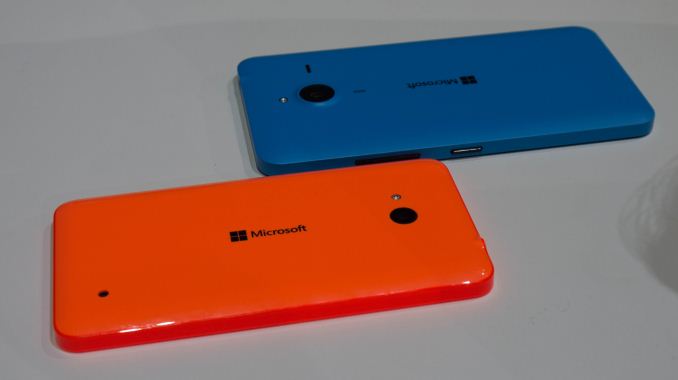
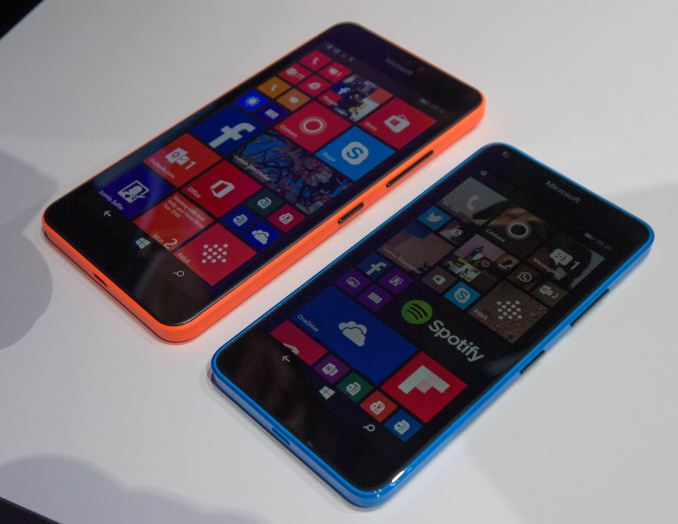
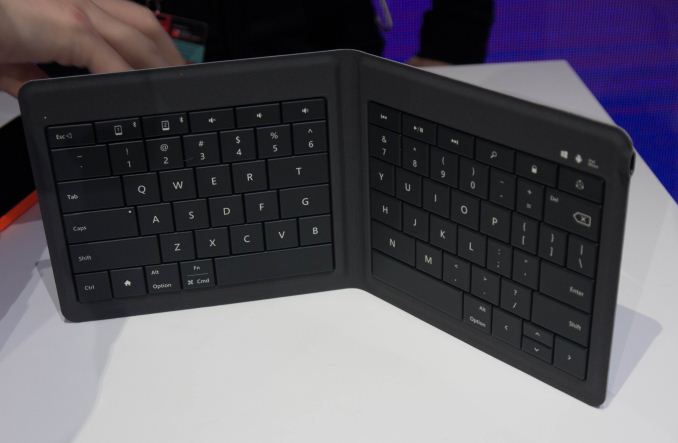






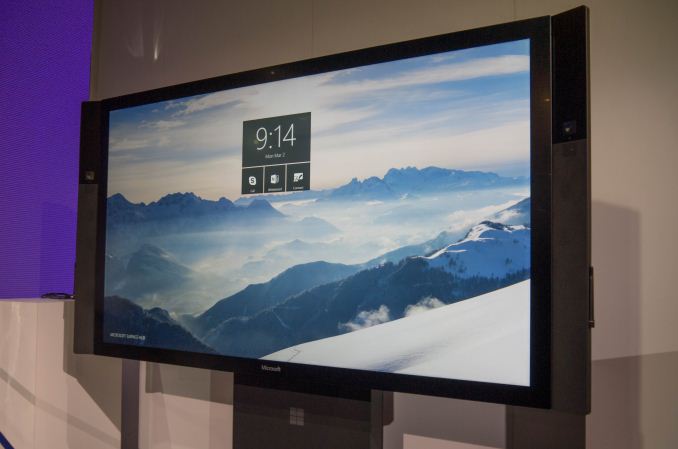
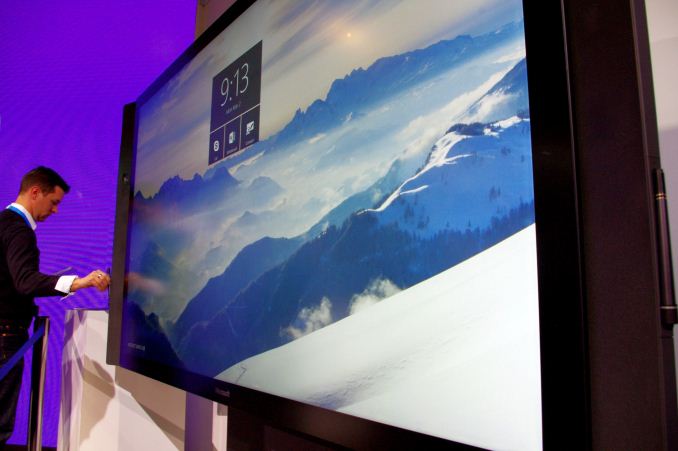














41 Comments
View All Comments
Laxaa - Monday, March 2, 2015 - link
The new Lumias look nice, and I'm glad that MS is continuing and refining the Lumia design language. It's also good to see additional confirmation of a Lumia flagship later this year. The 930 was a pretty good device, but it needed a bigger battery and more internal storage. I hope MS fixes this the next time around.jjj - Monday, March 2, 2015 - link
Noticed how no WP device is using A57/A53 cores?Seems that M$'s strategy to focus on one SoC supplier and not make the OS more flexible has backfired in a big way and will cripple WP phone sales just when they were pushing hard with more (smaller sized) partners. WP has less than 3% global share but this year with more partners they could have gained at least half a %. Poor sales for all those new models because of outdated hardware might make it very difficult for M$ to convince those partners to keep using Windows.
They keep trying to buy their way in but they need to stop messing up.
At least in glasses they are taking it seriously so that opportunity could save them.
Not so sure about that keyboard for mobile devices but might be interesting for the livingroom.
Laxaa - Monday, March 2, 2015 - link
They did announce support for Snapdragon 810 a couple of weeks ago. It was in the press release issued by Qualcomm announcing the official launch of the platform. I guess MS will wait for Windows 10 before they release 64-bit phones.jjj - Monday, March 2, 2015 - link
It's likely not ready yet and that's the problem, they can't really afford mistakes.As for Win 10 , if they would enable ARM desktops and desktop mode for docked mobile devices they could gain a lot of good will and a feature nobody else has yet so it would be nice to see that.It's the only thing that might excite me about Win 10 in mobile.
eanazag - Monday, March 2, 2015 - link
I want an ARM desktop form factor on Windows 10. I also like the concept of a docked mobile device that picks up desktop mode for the the ARM phones with Windows. Dual monitor support would be impressive - plus keyboard and mouse.Harry_Wild - Thursday, March 19, 2015 - link
Windows 10 mobile is only 32 bit OS! LOL!MrSpadge - Monday, March 2, 2015 - link
One can argue that the actual user experience is not really hampered by the older SoCs. But still.. it could obviously be better with newer ones.jjj - Monday, March 2, 2015 - link
UI fluidity might not be bad but actual perf is whet the hardware gives you and A53 at same clocks as A7 is plenty faster.And lets not forget that these new devices hit retail only in April so by that time a lot more Android devices with the new SoCs will be in retail.
Alexvrb - Monday, March 2, 2015 - link
It's not just UI fluidity. You aren't likely to run into any scenarios where the "slow" hardware holds back one of these devices. For a midrange WP device the 400 has plenty of power. I wish people wouldn't get so caught up in raw specs and instead let the final performance speak for itself.dishayu - Monday, March 2, 2015 - link
HAS to be MST, unless they're using DP 1.4 already. No other port has enough bandwidth for 4K@120Hz.